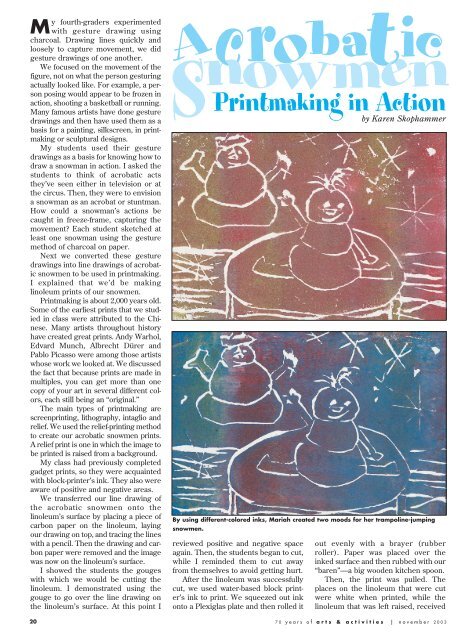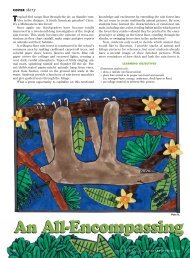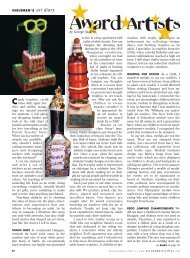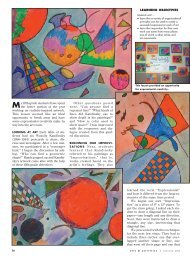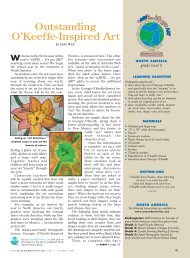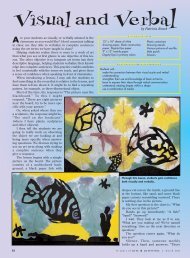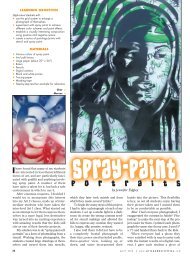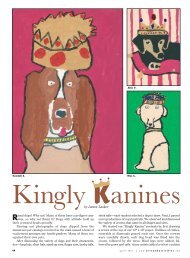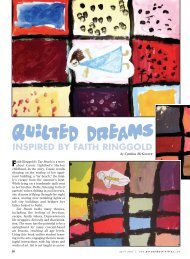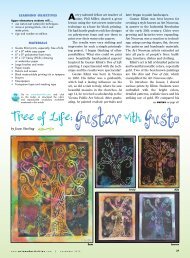to download a PDF of this article - Arts & Activities Magazine
to download a PDF of this article - Arts & Activities Magazine
to download a PDF of this article - Arts & Activities Magazine
Create successful ePaper yourself
Turn your PDF publications into a flip-book with our unique Google optimized e-Paper software.
My fourth-graders experimented<br />
with gesture drawing using<br />
charcoal. Drawing lines quickly and<br />
loosely <strong>to</strong> capture movement, we did<br />
gesture drawings <strong>of</strong> one another.<br />
We focused on the movement <strong>of</strong> the<br />
figure, not on what the person gesturing<br />
actually looked like. For example, a person<br />
posing would appear <strong>to</strong> be frozen in<br />
action, shooting a basketball or running.<br />
Many famous artists have done gesture<br />
drawings and then have used them as a<br />
basis for a painting, silkscreen, in printmaking<br />
or sculptural designs.<br />
My students used their gesture<br />
drawings as a basis for knowing how <strong>to</strong><br />
draw a snowman in action. I asked the<br />
students <strong>to</strong> think <strong>of</strong> acrobatic acts<br />
they’ve seen either in television or at<br />
the circus. Then, they were <strong>to</strong> envision<br />
a snowman as an acrobat or stuntman.<br />
How could a snowman’s actions be<br />
caught in freeze-frame, capturing the<br />
movement Each student sketched at<br />
least one snowman using the gesture<br />
method <strong>of</strong> charcoal on paper.<br />
Next we converted these gesture<br />
drawings in<strong>to</strong> line drawings <strong>of</strong> acrobatic<br />
snowmen <strong>to</strong> be used in printmaking.<br />
I explained that we’d be making<br />
linoleum prints <strong>of</strong> our snowmen.<br />
Printmaking is about 2,000 years old.<br />
Some <strong>of</strong> the earliest prints that we studied<br />
in class were attributed <strong>to</strong> the Chinese.<br />
Many artists throughout his<strong>to</strong>ry<br />
have created great prints. Andy Warhol,<br />
Edvard Munch, Albrecht Dürer and<br />
Pablo Picasso were among those artists<br />
whose work we looked at. We discussed<br />
the fact that because prints are made in<br />
multiples, you can get more than one<br />
copy <strong>of</strong> your art in several different colors,<br />
each still being an “original.”<br />
The main types <strong>of</strong> printmaking are<br />
screenprinting, lithography, intaglio and<br />
relief. We used the relief-printing method<br />
<strong>to</strong> create our acrobatic snowmen prints.<br />
A relief print is one in which the image <strong>to</strong><br />
be printed is raised from a background.<br />
My class had previously completed<br />
gadget prints, so they were acquainted<br />
with block-printer’s ink. They also were<br />
aware <strong>of</strong> positive and negative areas.<br />
We transferred our line drawing <strong>of</strong><br />
the acrobatic snowmen on<strong>to</strong> the<br />
linoleum’s surface by placing a piece <strong>of</strong><br />
carbon paper on the linoleum, laying<br />
our drawing on <strong>to</strong>p, and tracing the lines<br />
with a pencil. Then the drawing and carbon<br />
paper were removed and the image<br />
was now on the linoleum’s surface.<br />
I showed the students the gouges<br />
with which we would be cutting the<br />
linoleum. I demonstrated using the<br />
gouge <strong>to</strong> go over the line drawing on<br />
the linoleum’s surface. At <strong>this</strong> point I<br />
Printmaking in Action<br />
reviewed positive and negative space<br />
again. Then, the students began <strong>to</strong> cut,<br />
while I reminded them <strong>to</strong> cut away<br />
from themselves <strong>to</strong> avoid getting hurt.<br />
After the linoleum was successfully<br />
cut, we used water-based block printer’s<br />
ink <strong>to</strong> print. We squeezed out ink<br />
on<strong>to</strong> a Plexiglas plate and then rolled it<br />
by Karen Skophammer<br />
By using different-colored inks, Mariah created two moods for her trampoline-jumping<br />
snowmen.<br />
out evenly with a brayer (rubber<br />
roller). Paper was placed over the<br />
inked surface and then rubbed with our<br />
“baren”—a big wooden kitchen spoon.<br />
Then, the print was pulled. The<br />
places on the linoleum that were cut<br />
were white when printed, while the<br />
linoleum that was left raised, received<br />
20 70 years <strong>of</strong> arts & activities ❘ november 2003
LEARNING OBJECTIVES<br />
Students will...<br />
• define gesture drawing.<br />
• complete a gesture drawing <strong>of</strong> a<br />
classmate and a snowman.<br />
• transform the gesture drawing <strong>of</strong> a<br />
snowman in<strong>to</strong> a line drawing.<br />
• successfully cut the linoleum design.<br />
• successfully print an edition <strong>of</strong><br />
five prints.<br />
• analyze the mood <strong>of</strong> the prints.<br />
• name the types <strong>of</strong> printmaking.<br />
• name at least two artists who<br />
created prints.<br />
• define printmaking terms: brayer,<br />
block-printer’s ink, gouge, edition,<br />
positive, negative and pulling<br />
a print.<br />
Kelsey’s snowmen practice on the balance beam.<br />
Devon also chose a trampoline.<br />
MATERIALS<br />
• Charcoal pencils or charcoal<br />
• Paper<br />
• Artists works: Andy Warhol, Edvard<br />
Munch, Albrecht Dürer (see page 24)<br />
and Pablo Picasso<br />
• Linoleum<br />
• Linoleum gouges<br />
• Carbon paper<br />
• Water-based block-printer’s ink<br />
• Plexiglas plate<br />
• Baren or other utensil for rubbing the<br />
back <strong>of</strong> print<br />
the ink and was printed.<br />
I let the students mix colors <strong>of</strong> ink <strong>to</strong><br />
see what the mood <strong>of</strong> the print would<br />
be. Was there a different mood or feeling<br />
<strong>to</strong> a brightly colored print than<br />
from a black-and-white print Why<br />
The students were really enthused<br />
during <strong>this</strong> unit <strong>of</strong> study. It allowed<br />
them <strong>to</strong> think “outside the box” and<br />
encourage them <strong>to</strong> look more closely<br />
at the movement involved when people<br />
are in action.<br />
■<br />
Karen Skophammer teaches art for the<br />
Manson Northwest Webster Schools in<br />
Barnum and Manson, Iowa.<br />
Figure skating was the choice for Jason’s snowmen.<br />
www.artsandactivities.com 21


